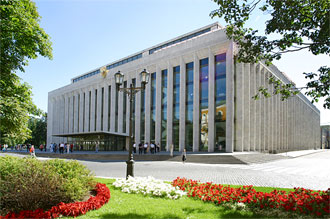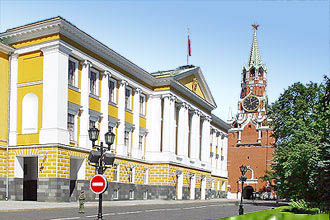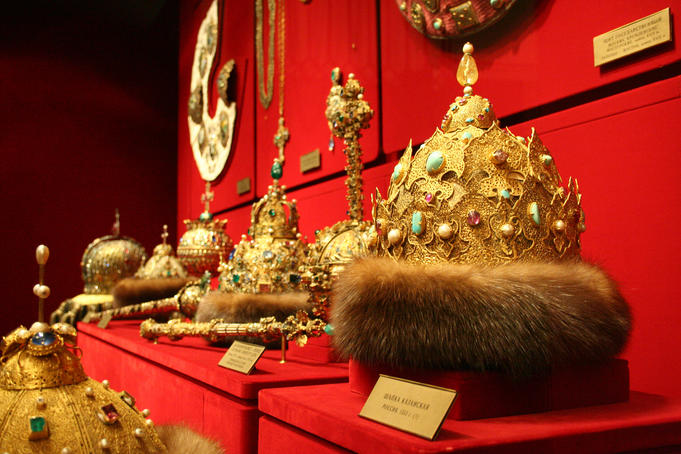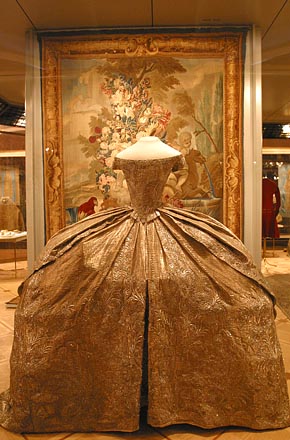2012, SEPTEMBER 8: RUSSIA, MOSCOW - KREMLIN
Moscow’s Kremlin is a fortified central complex of palaces,
churches, administrative offices, and an armory.
Public entry is through the Kutafya Tower, which leads to
a ramp connected to the Trinity Gate Tower.
 |
| Kutafya Tower & Trinity Gate (with Star), Kremlin, Moscow |
 |
| State Kremlin Palace, Kremlin, Moscow |
Arsenal, Kremlin, Moscow

Further ahead is the Senate building, with a flag on its top. Currently it serves as the official residence of the Russia’s President.
Senate Building, Kremlin, Moscow (Public Stock Photo)
On our way to the Cathedral Square we passed by a group of
tired tourists resting on the sidewalk.

Nearby was the Tsar Cannon. Made in 1586, the 40-ton, 35-inch caliber and about 16-1/2 feet long cannon was never used for its intended purpose.
The 200-ton Tsar Bell is just a few yards away. Like the Tsar Canon, it is the largest of its kind in the world. But made from the scraps of a previous bell, it was never successfully completed, or rung after it cracked in 1737
Then we entered the Cathedral Square. Starting in the 14ht century, and until 1710, when the capital was moved to St Petersburg by Peter the Great, it was the venue of coronations and assemblies of the nobility of the Tsarist Russia.
Cathedral Square, Kremlin, Moscow
The gilt dome of the more than 260-ft tall Ivan the Great
Bell-tower is the tallest structure of the Cathedral Square. A 64-ton bell
hangs from the adjoining belfry.
Great Bell Tower, Kremlin, Moscow
Marked by several small cupolas is the Church of the Nativity. A part of the Great Kremlin Palace complex, it was originally built in 1393, to honor the victory of Russian forces over a detachment of the Mongol (Golden) Horde.
Assumption Cathedral is the oldest, largest, and most important of the Kremlin's many churches. All manner of coronations, funerals, victory services, and important ceremonies have been held here, since it was built in the 1470s as the seat of the Russian Orthodox Church. Upon its completion, its Italian builder Alberti Fioravanti was imprisoned, and he died in captivity a few years later.
Assumption Cathedral
The golden-domed Cathedral of the Annunciation was the private chapel of the Tsars. An interesting feature of this 15th century building is a porch that was added to allow Ivan the Terrible to pray, after he had been barred from entering the Cathedral upon his fourth marriage, against the prevailing church doctrine.
Cathedral of the Annunciation

After leaving the Cathedral Square, we walked past the Great Kremlin Palace to the Armory.
Great Kremlin Palace
Great Kremlin Palace
Originally a warehouse for the Kremlin’s weapons, the Armory soon became a workshop and storehouse for all sorts of treasures of the Imperial court.
The Armory, Kremlin, Moscow
After the Napoleon's invasion, in 1813, the Armory building was
converted into a museum for Imperial arms and regalia. The exhibits include
gem-and diamond-studded coronation caps and thrones; brocade and silver
vestments, capes, and gowns; Faberge eggs; and royal carriages. The carriages
included one on sleds that Elizabeth used to travel in winter, for her
coronation, the distance of about 400 miles from St. Petersburg to Moscow!

Imperial Crowns, The Armory, Kremlin, Moscow (open Stock Photo)


Queen's Brocade Gown & Imperial Carriage, Armory, Kremlin, Moscow ((Open Stock Photos)
By the time we were done with the Kremlin visit, we were very tired. Soon after reaching our hotel, we had dinner and went to bed, to prepare for our 8 a.m. departure for Minsk, Belarus.










0 Comments:
Post a Comment
<< Home